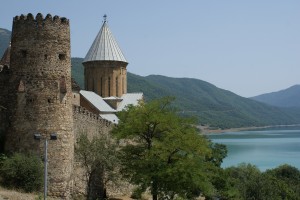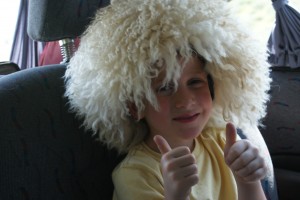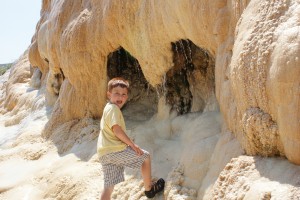After overnighting in Tbilisi, it was back in the van the next day. We would be heading into the High Caucasus Mountains for the first time. The Caucasus is the heart and soul of Georgia – these mountains have shaped the culture, the language, the religion, the food, everything. We were heading to Stepantsminda, the very last town before the Russian border.
The road leading to the mountain is known as the Military Highway. Built in the 1800’s after Russia annexed the Caucasus, it is the main route between Tbilisi and Vladikavkaz, in Russia. The drive is spectacular. We stopped at the fortress of Ananauri – yes, another imposing building with a church of course, this time located above a beautiful lake. The problem with so much in Georgia is that places that would be national treasures anywhere else are so neglected. Ananauri is in good shape, but just below it is what should be a fabulous beach – but it was unkempt and litter was everywhere. With luck in the future, this beautiful site will be cleaned up and developed in an environmentally friendly way. I’d stay at a hotel here, if it existed!
After Ananauri the road makes it way through verdant green valleys and the hillsides became higher and higher, ultimately becoming mountains in their own right. There are some incredible stopping points – after passing the ski resort of Gudauri, we came to a soviet designed viewing platform – an eyesore for some perhaps, but it is an artistic work in its own right, with its huge stylized art portraying of Russian-Georgian friendship. Whatever ones politics, the views from here are incredible. The hills here are very steep, and this is also a trailhead for an ambitious hike into the canyon below. We met some Israeli hikers planning to do the hike – we later learned that one of them had fallen badly down the mountainside and had to be airlifted back to Israel. In Georgia there are very few railings, safety warnings and similar – one has to be very careful at all times in the mountains.
Along the way, we stopped at a honey seller – he had a tent pitched, and who knows how long he had been camped on the side of the road, selling honey from the beehives along the side. We also stopped at women selling traditional sheepskin and wool mountain hats we bought one, and though it smelled strongly of sheep, it was an unforgettable souvenir!
Malchas, our driver, had another stop for us, not mentioned in any guidebook. Further along the highway, we stopped the car and he led us to a thermal feature on the opposite hillside which had warm water cascading down it. Over the years the calcium in the water had hardened, and this thermal feature looked much like the famous features we had seen in Yellowstone in 2009. The difference here was that this site was totally free to clamber upon, and the kids had a great time climbing up the rock. Malchas told us that he had discovered this after having been stranded here in a winter blizzard for over 2 days once, on his way back from Russia.
Eventually we reached Stepantsminda (also known as Kazbegi). This town is famous for the site of the Tsminda Sameba church, built high above the town in the shadow of Mount Kazbek. We would be visiting the church the following morning.
We had arranged to stay in a homestay here, but after one look at our proposed lodging, we changed our minds and headed for the only hotel in town – the Hotel Stepantsminda – grossly overpriced at about $150 for the room, it was nevertheless clean and had a good bathroom on suite. This must have been what the hotels in the former Soviet Union must have been like – no choice, drab, expensive, and with non-existent service.
After unpacking, we asked Malchas to take us to the border with Russia. The road runs along the Dariali Gorge and is incredibly scenic – the grey river rushes fiercely, hemmed in by the huge hills on either side. We had to turn around at the Georgian border post. Most interestingly, a church was under construction just inside the Georgian border – it is clear that churches are a symbol of modern Georgian independence, and this church symbolises this – Malchas told us that almost yearly, Russian troops cross the border for a few hours, just to show who is boss in the area, before going back to their own side. Georgia is powerless to stop this, and have built a church instead.
Back in town, I wandered around the back streets with the boys. We met some inquisitive local kids as well as a some adults, who seemed bemused by our presence. What really bothered us, were the huge buildings, overgrown with weeds and boarded up. One was clearly as school, its playground a veritable jungle of weeds and overgrowth, while others may have been , who knows – a hotel, a resort, a hospital?
The dinner buffet in the hotel was ok – apparently it was much better than the one or two other eating places in town.
PS: These days I help families plan incredible trips to destinations on five continents. Click here for more info.



